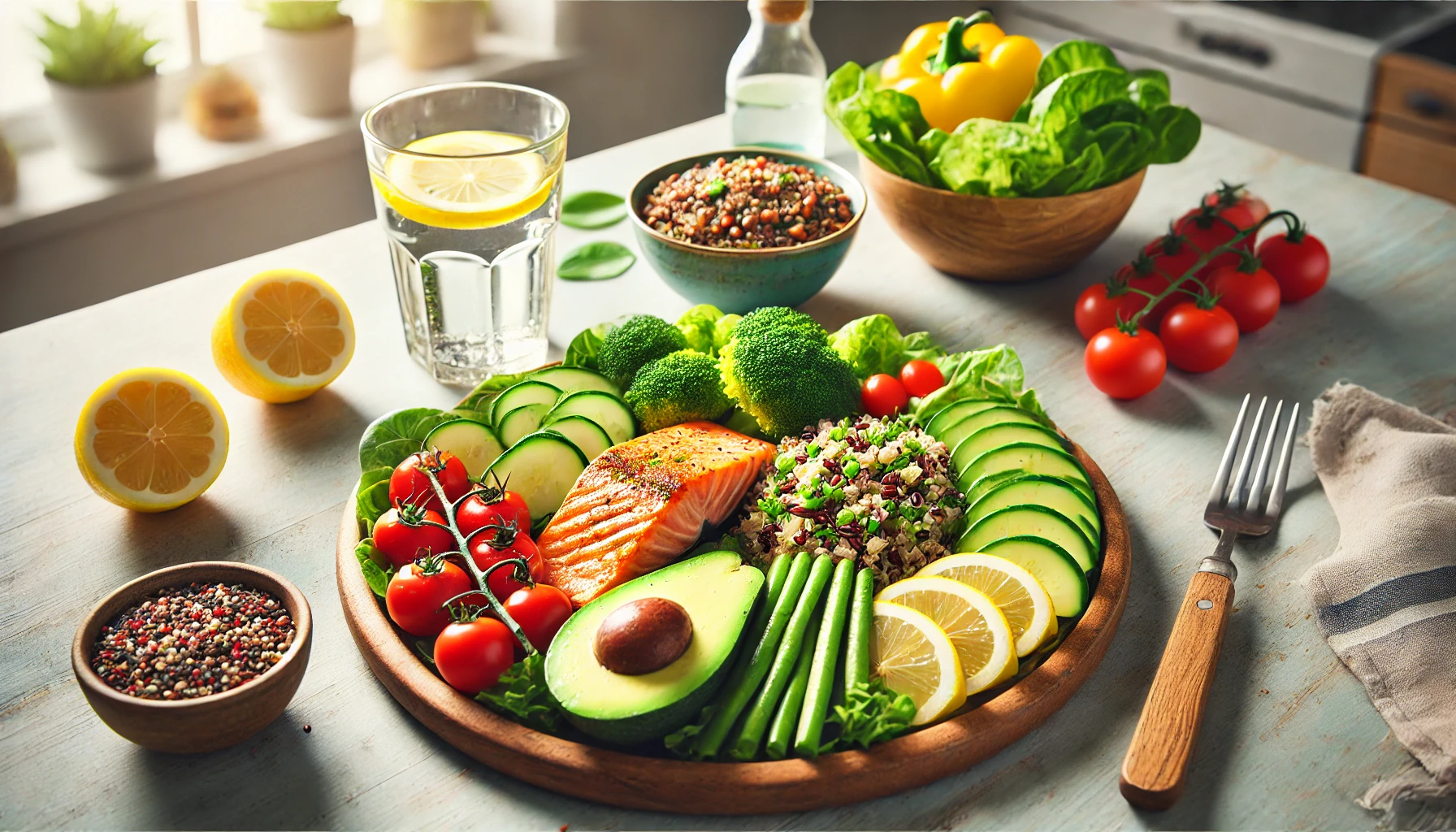A balanced diet is essential for maintaining good health, boosting energy levels, and preventing chronic diseases. Eating the right combination of nutrients ensures that your body functions at its best, helping you feel and perform better in your daily life.
In this article, we’ll explore what makes a diet balanced, the key food groups to include, and practical tips for making healthier choices.
1. What Is a Balanced Diet?
A balanced diet provides your body with the nutrients it needs to function correctly. This means consuming a variety of foods in the right proportions, including:
- Carbohydrates: Provide energy for daily activities.
- Proteins: Help build and repair tissues.
- Fats: Support brain function and hormone production.
- Vitamins and Minerals: Essential for overall health and disease prevention.
- Fiber: Supports digestion and gut health.
- Water: Keeps the body hydrated and aids in various bodily functions.
Eating a wide range of nutrient-rich foods ensures that you get all the necessary vitamins and minerals your body needs.
2. The Importance of Macronutrients
2.1 Carbohydrates: The Body’s Primary Energy Source
Carbohydrates are often misunderstood, but they are essential for energy. However, the type of carbohydrates you consume matters.
Healthy Sources of Carbohydrates:
- Whole grains (brown rice, quinoa, whole wheat bread)
- Fruits (bananas, apples, berries)
- Vegetables (sweet potatoes, carrots, peas)
- Legumes (beans, lentils, chickpeas)
Carbohydrates to Limit:
- Refined grains (white bread, white rice)
- Sugary drinks and processed snacks
- Pastries and desserts
Choosing complex carbohydrates over simple sugars helps maintain stable blood sugar levels and provides long-lasting energy.
2.2 Proteins: Building Blocks of the Body
Protein is essential for muscle growth, immune function, and tissue repair.
Best Sources of Protein:
- Lean meats (chicken, turkey, fish)
- Eggs
- Dairy products (Greek yogurt, cheese)
- Plant-based options (tofu, lentils, quinoa, nuts)
Including a mix of plant and animal proteins ensures a complete range of amino acids.
2.3 Fats: Essential for Brain and Heart Health
Fats are vital for brain function, hormone production, and absorbing fat-soluble vitamins.
Healthy Fats to Include:
- Avocados
- Nuts and seeds (almonds, walnuts, chia seeds)
- Olive oil and coconut oil
- Fatty fish (salmon, sardines)
Avoid trans fats found in processed and fried foods, as they increase the risk of heart disease.
3. The Role of Micronutrients
3.1 Vitamins and Minerals
Vitamins and minerals support bodily functions such as immunity, bone health, and metabolism.
Key Vitamins and Where to Find Them:
- Vitamin C: Citrus fruits, bell peppers, strawberries
- Vitamin D: Sunlight, fatty fish, fortified dairy
- Vitamin B12: Meat, eggs, dairy, fortified plant foods
- Iron: Red meat, spinach, beans
3.2 Fiber for Digestion
Fiber helps regulate digestion, supports gut health, and keeps you full for longer.
Best Sources of Fiber:
- Whole grains (oats, brown rice, whole wheat pasta)
- Vegetables (broccoli, carrots, kale)
- Fruits (apples, pears, oranges)
- Nuts and seeds (chia, flaxseeds, almonds)
Eating enough fiber can help prevent constipation and reduce the risk of heart disease.
4. Hydration: The Forgotten Nutrient
Water is crucial for every function in the body, from digestion to temperature regulation. Dehydration can lead to fatigue, headaches, and poor concentration.
How Much Water Do You Need?
- Men: Around 3.7 liters (125 ounces) per day
- Women: Around 2.7 liters (91 ounces) per day
Hydration needs may vary based on activity level, climate, and overall health.
5. Practical Tips for a Balanced Diet
5.1 Eat a Variety of Foods
No single food provides all the nutrients you need, so aim to include a mix of protein, healthy fats, and complex carbohydrates in your meals.
5.2 Control Portion Sizes
Eating too much of even healthy foods can lead to weight gain. Use smaller plates, avoid eating straight from the package, and listen to your body’s hunger cues.
5.3 Plan Your Meals in Advance
Meal planning helps ensure balanced nutrition and prevents last-minute unhealthy choices.
How to Meal Plan Effectively:
- Make a shopping list with whole, unprocessed foods.
- Cook meals in batches to save time.
- Include healthy snacks like nuts, yogurt, or fruit.
5.4 Reduce Processed Foods and Added Sugars
Processed foods often contain high amounts of sodium, unhealthy fats, and sugars. Try to cook at home as much as possible to control ingredients.
5.5 Practice Mindful Eating
Being mindful while eating can help you enjoy food more and prevent overeating. Avoid distractions like TV or smartphones and eat slowly.
6. Sample Balanced Meal Plan
Here’s an example of a balanced day of eating:
Breakfast:
- Scrambled eggs with whole wheat toast and avocado
- A glass of water or herbal tea
Lunch:
- Grilled chicken with quinoa and roasted vegetables
- A small side of mixed greens with olive oil dressing
Snack:
- Greek yogurt with almonds and honey
Dinner:
- Baked salmon with brown rice and steamed broccoli
- A fruit salad for dessert
Eating balanced meals throughout the day ensures that you get the nutrients you need to stay healthy and energized.
Final Thoughts
A balanced diet isn’t about strict rules or deprivation—it’s about nourishing your body with the right foods. By focusing on whole foods, controlling portion sizes, staying hydrated, and making mindful choices, you can build long-term healthy eating habits that support your well-being.
Start small, make gradual changes, and enjoy the journey to better health!

